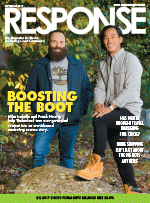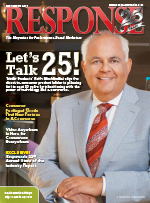 Following closely on the heels of my (admittedly quite late) look back at our October issue, let’s take a gander at the November book, which is headlined by a cover feature on well-known shoe and apparel brand Timberland. Our second issue under our sleek new masthead and tagline also features our annual look at the travel marketing space and an update on the technological advances driving the expanding home shopping space. And, as usual, there’s the latest look at media billings statistics, as well as a trove of intriguing thoughts and opinions in our column well. Let’s take a look at the issue’s highlights and how the key stories came together.
Following closely on the heels of my (admittedly quite late) look back at our October issue, let’s take a gander at the November book, which is headlined by a cover feature on well-known shoe and apparel brand Timberland. Our second issue under our sleek new masthead and tagline also features our annual look at the travel marketing space and an update on the technological advances driving the expanding home shopping space. And, as usual, there’s the latest look at media billings statistics, as well as a trove of intriguing thoughts and opinions in our column well. Let’s take a look at the issue’s highlights and how the key stories came together.
- In early June, I attended an educational session at the IRCE event in Chicago featuring Timberland’s Frank Hwang and representatives of Olapic, an agency specializing in maximizing the effects of user-generated content. Rightfully intrigued by the success of the company’s “We Built It, You Made It” campaign for its iconic Yellow Boot (yes, that’s Frank sporting a pair on the cover), I spoke with Frank and the Olapic team after the session. Upon returning home, I was connected with Nora Garrity, Timberland’s senior PR manager. With Nora’s tremendous assistance, we began to build what became this three-pronged cover feature, which includes interviews with Frank, Mike Isabella, the company’s consumer engagement director (also on the cover), and Jim Davey, Timberland’s vice president of marketing. If you missed the link above, click here for Timberland’s story of using performance-based marketing to promote such a strong brand in this consumer-centric era (and, yes, the headline indeed comes from the classic John Coltrane song/album): Giant Steps
- One of our key freelancers, Nicole Urso Reed, says urges for one-stop shopping and personalized service are tweaking travel marketing in new and different ways. Yes, the power of the Expedias, Orbitzes, and other all-in-one discounters is here to stay. But discerning travelers are seeking more: more chances to check out reviews and book in the same place (think TripAdvisor); and more opportunities to create their own specialized itineraries with the help of local or demographic experts — think old-school travel agents, but better. Check out the story for more: All-Inclusive Adventures
- As anyone who’s been around more than a few years knows, the home shopping TV networks are the (still living) ancestors of today’s e-commerce megasites. So, if you thought that QVC acquiring HSN and becoming the nation’s third-largest e-commerce player was the story of the year in home shopping, well … yea, you’re right. But, as usual, freelancer Bridget McCrea digs deeper to find that some of the smaller, more nimble players are driving advances in the home shopping space, particularly through the use of mobile apps and other digital technologies. Here’s that link again: Home Shopping’s Digital Evolution
- Our monthly direct response TV and radio media billings research focuses on second-quarter 2017 short-form DRTV research provided by our partner Kantar Media. After ending a bit of a losing streak during the second-half of 2016, the short-form space has continued gaining ground in the first half of this year. As a matter of fact, 2Q results left the short-form market up by more than $327 million during 2017’s first six months compared to the same period of the year earlier. For a full look at 2Q 2017 short-form DRTV media billings, click here: Short-Form DRTV Billings Reach a Year’s Worth of Hikes
- The November issue also features a trio of solid submissions in our column section:
- In a strong Media Zone piece, Koeppel Direct‘s Peter Koeppel delivers five suggestions on how to reach the coveted millennial market.
- In a timely Support Services column, Moulton Logistics‘ Patrick Moulton says a marketer’s job is only half done when they make it to a home shopping network. With more home shopping outlets now preferring drop-shipping, what do marketers need to know about this particular back-end service?
- Barbara Kerry‘s Production House column tackles the other end of the generational spectrum, as Script to Screen‘s leader says that TV remains a powerful tool to reach Boomers, who still hold much of the nation’s spending power.
- Finally, the inspiration for my Editor’s Note column about valuing the power of experiences over the accumulation of things (and what that might mean for marketers) came partly from an October spent attending the National League playoffs and World Series at Dodger Stadium. Though my childhood team (yes, the Dodgers) eventually lost Game 7 of a great World Series to the Houston Astros, the experience of attending all eight of L.A.’s 2017 home playoff games is one that will live with me forever. Reaching consumers’ indelible memories to create an emotional attachment to a brand is a strategy as old as advertising itself (just see the “Mad Men” clip I reference in the column). But what’s different about consumers today? That’s where the column has some thoughts you might carry ahead: Consumers Can Power Campaigns With Powerful Experiences
Thanks again for reading and interacting with Response!

